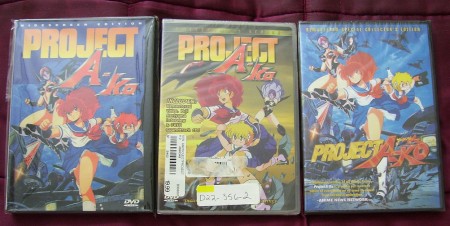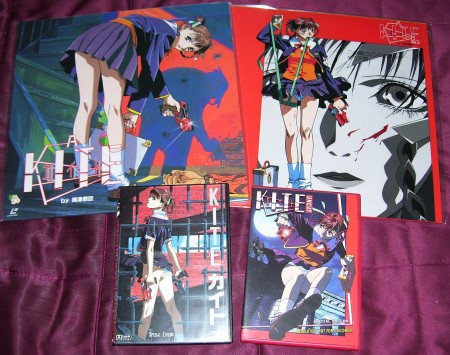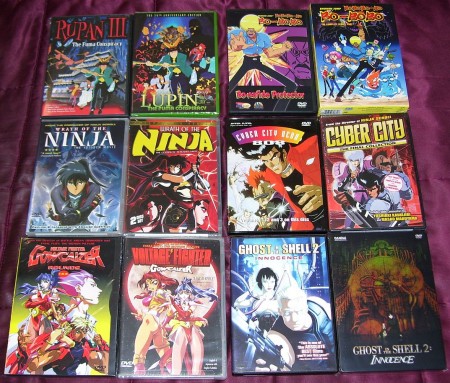Doing the Double Dip
Home video collectors are a particular breed who feel a personal connection to particular movies and cinema, urging us to want to own particular favorite films. We want the films we like to be nearby, like a domestic pet, to gratify and validate us. Ordinary people purchase the movies or TV shows they enjoy in order to re-watch them periodically, thus a watchable copy is perfectly sufficient. But collectors are more deeply engaged with their favorite films. Since we feel personally invested in those films and associate those films with our own self-identity, we want the versions of those films which satisfy us most. And because we always want the film close at hand, we feel obligated to constantly upgrade with newer formats, fancier and more comprehensive editions, and remastered, more pristine presentations. Although perhaps not with such psychologically scrutiny, the home video distribution industry recognizes and capitalizes on this compulsion with the “double dip.” An extra scoop is usually welcome. An improvement is commendable. But when relevant to home video, the “double dip” is like ice cream sprinkled with jalapeno. It’s a bitter pleasure that collectors face with equal amounts of anticipation and frustration. We’re being taken advantage of, but at heart the situation still involves something pleasurable, so we grit our teeth, rationalize, and concede.
After purchasing The Evil Dead again I was struck by an ironic realization.
I was stunned just a bit by the ephphany that although anime is my foremost love, the movies I’ve purchased most often have not been anime. I wonder if any film in the history of Hollywood has been released to commercial home video more times than The Evil Dead. While I never owned the film on VHS or LD, I first purchased the “Cover I” edition Anchor Bay DVD in 1999. Then I upgraded to the 1999 Elite Entertainment Special Edition DVD. Then I purchased Anchor Bay’s 2002 “Book of the Dead” DVD. Then in 2007 I upgraded again to the Anchor Bay “Ultimate Edition.” Then I grudgingly upgraded yet again to the 2010 double-disc limited edition Blu-ray. Purchasing the same film five times seems to be a record for me. By comparison, I’ve only purchased Evil Dead 2 three times, and Army of Darkness twice. My record with The Evil Dead is tied by the five times I’ve purchased Highlander: Republic Pictures’ 1996 10th Anniversary Director’s Cut laserdisc, Republic Pictures’ 2000 10th Anniversary Director’s Cut DVD, Anchor Bay’s 2002 Immortal Edition DVD limited edition, Optimum Releasing’s UK exclusive 2007 Immortal Edition Steelbook DVD, and most recently Lionsgate’s 2010 Blu-ray. (I also take pride in the fact that I’ve never purchased any Highlander video besides the original movie.) Ranking just below The Evil Dead and Highlander, I purchased Toho’s Lone Wolf & Cub movie sextet on AnimEigo’s VHS, then laserdisc, then DVD. And I’m certain that I’ll upgrade again to the forthcoming Blu-ray release.
Anime is not without its multiple iterations, upgrades, and re-releases, with Robotech certainly dwarfing all other titles. The Macross Saga hit American VHS from F.H.E. in 1985, 1987, and 1993, laserdisc in 1993, Perfect Collection VHS from Streamline in 1994, a single-episode CD-ROM from GameTek Cinema in 1994, DVD from AD Vision in 2001 followed by ADV’s 2004 Robotech Remastered release, then A&E’s 2011 DVD release. Excluding the American edited Robotech, I can only recall two Japanese language anime that have had five distinct domestic releases. Akira hit VHS in 1991 then subtitled VHS in 1999. It premiered on domestic DVD in 2001 then got a DTS upgrade in 2002 followed by an American Blu-ray release in 2009. Project A-ko hit domestic VHS and LD from Central Park Media, 1999 letterboxed DVD from Image Entertainment, full screen “Collector’s Series” DVD from CPM in 2002, and remastered DVD from Discotek in 2011. The Fist of the North Star movie first hit American VHS in 1991 thanks to Streamline. Image Entertainment then released it on DVD in 1998. DiscoTek released the film on bilingual DVD in 2009 then quietly rolled out a second edition DVD with “propered” subtitles, creating a fourth distinct release. MD Geist has had four distinct American releases on VHS, CPM DVD, Director’s Cut DVD, and then a DVD re-release by AD Vision. I don’t know if ADV’s release was merely a repackage of the CPM DVD or a new encode, but it ought to count as a distinct fourth release just by virtue of it coming from a new distributor.
Numerous anime titles have had three distinct American releases, excluding mere changes in packaging; among them, the Dirty Pair OVA series (ADV VHS & DVD, Nozomi DVD), Cowboy Bebop & Trigun (VHS, DVD, Remix DVD), Rhea Gall Force (VHS, Image DVD, CPM DVD), Darkside Blues (VHS, CPM DVD, ADV DVD), Megazone 23 (VHS, Image DVD, ADV DVD), My Neighbor Totoro (Fox VHS & DVD, Disney DVD), and Rei Rei (Softcel VHS & DVD, Critical Mass DVD). Evangelion has been released in VHS, DVD, Perfect collection DVD, Platinum DVD, Platinum Perfect Collection DVD (with tin case), Platinum Collection DVD (in thinpak), and Platinum Collection Limited Edition Holiday Special DVD, but those seven iterations constitute only three different release versions: VHS, DVD, and Platinum Edition DVD. I’m consciously excluding the two “Director’s Cut” DVDs since they only cover four out of 26 episodes.
In terms to total number of anime releases, I may top out with Dirty Pair after buying the domestic ADV OVA series VHS tapes, the domestic ADV DVDs, the Japanese complete series DVD boxed set, then the current Nozomi domestic DVDs, not to mention a random few Japanese laserdiscs along the way. I bought the Blood: The Last Vampire movie on Japanese limited edition DVD, then domestic DVD, then domestic Blu-ray. I also purchased Mononoke Hime on Japanese VHS, Japanese DVD, then domestic DVD. I purchased A-Kite on two Japanese laserdiscs, on uncut & uncensored German DVD, then finally on uncut & uncensored domestic DVD. But the only purely domestic release besides Dirty Pair that I’ve purchased three times may be Project A-ko. I own all three American DVD editions of Project A-ko but never purchased the movie on domestic VHS or LD. The number of times I’ve purchased an anime title twice, either to upgrade to a new format or supplement an extinct release with a newer release, is far too many to list or even, honestly, recall.
So how about you? How often have you upgraded or succumed to “double-dipping” or even “triple-dipping”? (Remember that relatively few American anime releases have had more than three distinctly different releases, excluding simple changes in packaging or SRP.) Which titles convinced you to re-buy?
Add a Comment
You must be logged in to post a comment.






Since I was lucky enough to get into anime during the waning VHS days, I got to upgrade a few of my favorites from VHS to DVD, but my VHS collection was never massive, so DVD is where most of my current collection began.
Ninja Scroll and the Evangelion series are the first to come to mind as titles I got on VHS, then DVD. If either ever came to Blu-ray (Eva movies notwithstanding), I’d pick them up yet again. Ghost in the Shell would be in that category too if the sub-par Blu-ray release hadn’t kept me from picking it up again.
Totoro I had on VHS, then DVD. That’s another I’d get again on Blu-ray.
One title I’d love to see remastered then re-released so I can buy it again is the original Berserk series. I don’t have a good impression of the new movie trilogy coming out (I share John’s CG concerns), but the original series is a classic that could use some polishing for modern hi-def displays.
I have done double dipping mostly with upgrading stuff I have on vhs to dvd. Sometimes accidentally or to win something. I have trigun movie both formats and Remix plus the box set funimation put out. I have double dip because different versions like you see Bobobo and Lupin above.
“DVD from AD Vision in 2001 followed by ADV’s 2004 Robotech Remastered release”
You mean DVD from Animeigo. ADV DVDs were reissues.
As for myself, I only double-dip for extras and remasters, which is why I just got Panda go Panda, with Golgo next.
I try not to do a lot of double-dipping largely out of necessity… I don’t have a lot of room in my apartment for storage. If it doesn’t fit on my bookshelves or in that space behind the entryway chair, then I’ve got problems.
I’ve double dipped on AH! MY GODDESS (movie), BGC: TOKYO 2040, TRIGUN, GUNDAM W, DARKSIDE BLUES, 3×3 EYES, various DBZ items (picking and choosing my favorite episodes, APPLESEED, and some others (Japanese collector’s laserdisc of PERFECT BLUE? Awesome.).
The best upgrade I’ve endured was probably for BLUE SUB 6, which was sold through individual volumes (VHS and DVD), movie versions, a “Toonami version,” and more. The complete collection, with an onion sleeve, was the last version I purchased, and I still adore it.
I’m pretty sure I’ve triple dipped on MACROSS PLUS. One of the greatest and most best-est anime in the history of mankind. Ha!
Also, I stopped collecting/reading manga on a regular basis some time ago, but I still have multiple copies of my favorites.
Just for clarification. AnimEigo has never released any Robotech on any home video format. AnimEigo released Japanese language Superdimensional Fortress Macross on subtitled DVD, but never any Robotech. AD Vision also released a bilingual version of Superdimensional Fortress Macross with slightly different subtitles and a new DVD transfer. ADV also separately released Robotech and Robotech Remastered on DVD.
Yeah, that complete set version of Blue Sub No. 6 is nice because it’s the only release that includes the bonus features DVD.
it’s been such a long time since I’ve either replaced VHS with DVDs or converted them to digital files and pitched the tapes that I don’t completely remember what I had on tape. Evangelion, some early-season Ranma TV and the OVAs, Nadesico, some of the Nadia VHS tapes, Key the Metal Idol, Ninja Scroll, some Ghibli stuff…
A more frequent practice has been for me to ditch older singles in favor of Complete Collections in order to regain some shelf space. But repackaging’s not a “dip” if we’re going by John’s guidelines.
John: So you’re gonna keep your subbed Bobobo set INO?
Well, to be honest, I have lost count of the titles I have double dipped during my conversion process from VHS to DVD. And the truth is, I am still going even today. I remember e-mailing John about this very topic a few years ago when the process was just beginning asking for a recommendation on what to do with the old VHS tapes. As for ditching singles in favor of box sets, I am guilty of that as well most recently with Genshiken, and will likely do so with my Dirty Pair DVD’s.
I just re-bought Kaleido Star season 2, because I wanted the Linda Hamilton OVA that was included on the new release of it, and the original publisher that I bought it from didn’t include that. Nobody ever published the OVA by itself in the US.